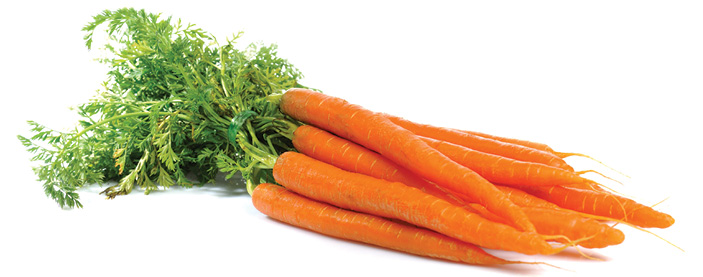Growing
Nantes varieties are generally recommended for home gardeners. Before sowing seeds, prepare the soil. Deep, loose, well-drained soils will produce the straightest, smoothest carrots. Compost may be added to improve soil fertility.
Sow in early spring to midsummer. Sow seeds a inch apart, ¼ inch deep, in rows spaced 18 to 24 inches apart. If necessary, thin seedlings to stand 1 to 2 inches apart.
Don’t allow the soil to crust until seedlings emerge; this may take up to three weeks. Carrot beds can be sprinkled with mulch to retain moisture and to block sunlight that turns carrot crowns green.
Harvesting
Dig carrots when they reach a desired length. This is usually 60 to 80 days after sowing. Keeping the roots in the ground for a month or longer after this time may reduce taste qualities and lead to cracking.
Storing
Fresh-harvested carrots should be scrubbed to remove excess dirt and washed in cold water. Then cut about ½ inch from the top of each carrot, removing the greens. Air-dry the carrots and store them in an air-tight plastic bag in the refrigerator to maintain proper humidity. If the carrots are not in air-tight bags, they may become limp in the refrigerator.
Carrots will maintain their freshness
longer at or around 32 F
Preparing
Carrots can be cooked in the oven, microwave, on the stove top or in a slow cooker. For example, cover carrots with foil for cooking in the oven; bake at 425 F for 30 minutes. Cut larger carrots into strips or smaller coin shapes, depending on the cooking plan. Toss carrots in olive oil, salt, pepper and other seasonings for added flavor. Garlic, balsamic vinegar, butter, brown sugar, honey, maple syrup, lemon zest, chives, green onions and chili powder are good accompaniments to carrots.
Preserving
Did you know that carrots were the first commercially canned vegetable? Carrots can be frozen, pressure-canned, pickled or dehydrated.
Follow current pressure-canning procedures in the NDSU Extension publication “Home Canning Low-acid Vegetables” (FN173).
For more information about freezing, see the NDSU Extension publication “Freezing Vegetables” (FN187).
For more information about pickling, see the NDSU Extension publication “Making Pickled Products” (FN189).
Nutrition
One medium-sized carrot (about 7 inches) has 35 calories, 0 g protein, 0 g fat, 9 g carbohydrate, 2 g fiber and 45 mg sodium. Carrots are notable sources of beta-carotene, which the human body converts to vitamin A. Vitamin A promotes healthy skin and eyes.
Recipes
Key to abbreviations
c. = cup
tsp. = teaspoon
Tbsp. = tablespoon
g = gram
mg = milligram
Roasted Carrot and Pear Soup
4 c. carrots, peeled and cut
2 pears, peeled and cut
2 Tbsp. olive oil, divided
¼ tsp. salt
1 medium yellow onion, chopped
1 large garlic clove, minced
1 tsp. grated fresh ginger
6 c. vegetable stock
2 sprigs fresh thyme (used in roasting pan)
Optional: fresh thyme to garnish
Preheat oven to 400 F. In a large bowl, toss carrots and pears with 1 Tbsp. olive oil, salt and thyme sprigs. Place mixture in a shallow roasting pan with cover. Roast for 40 minutes or until tender, stirring halfway through cooking. When carrot mixture is almost ready, place large soup pot over medium heat. Add 1 Tbsp. oil and onions, and cook until tender. Stir in garlic and ginger, and cook for one minute, stirring constantly. Add the roasted carrots and pears to soup pot, discarding the thyme stems. Add vegetable stock and bring to boil. Reduce heat and simmer for 10 to 15 minutes, until carrots are soft. Use a blender or immersion blender to puree the soup until smooth.
Makes eight (1 cup) servings. Each serving has 90 calories, 3.5 g fat, 16 g carbohydrate, 1 g protein, 4 g fiber and 120 mg sodium.
Roasted Dill Carrots
36 baby carrots
2 Tbsp. canola oil
1 tsp. salt
½ tsp. black pepper
2 Tbsp. minced fresh dill
Preheat oven to 400 F. Cut baby carrots diagonally. Toss carrots in oil. Season with salt and pepper; toss again. Use sheet pan with parchment paper and transfer carrots in one layer. Roast in oven for one hour or until browned, stirring occasionally. Toss carrots with dill after they are finished roasting.
Makes four servings. Each serving has 90 calories, 7 g fat, 8 g carbohydrate, 1 g protein, 3 g fiber and 650 mg sodium.
Carrot Muffins
1 large egg
1 c. unsweetened applesauce
½ c. honey
3 Tbsp. canola oil
1 tsp. vanilla extract
1½ c. whole-wheat flour
1 tsp. baking soda
1 tsp. ground cinnamon
¼ tsp. salt
1 c. finely shredded carrots
Preheat oven to 350 F. In a large bowl, combine egg, applesauce, honey, oil and vanilla. In another bowl, combine flour, baking soda, cinnamon and salt. Stir into wet ingredients. Fold the shredded carrots into the muffin batter. Place batter into greased or lined muffin tin. Bake for 20 to 25 minutes or until toothpick inserted in the muffin center comes out clean. Cool muffins before serving.
Makes 10 servings. Each serving has 170 calories, 5 g fat, 31 g carbohydrate, 3 g protein, 3 g fiber and 200 mg sodium.
Funding for this publication was made possible by the U.S. Department of Agriculture’s Agricultural Marketing Service through grant AM190100XXXXG028. Its contents are solely the responsibility of the authors and do not necessarily represent the official views of the USDA.
For more information on this and other topics, see www.ndsu.edu/extension


